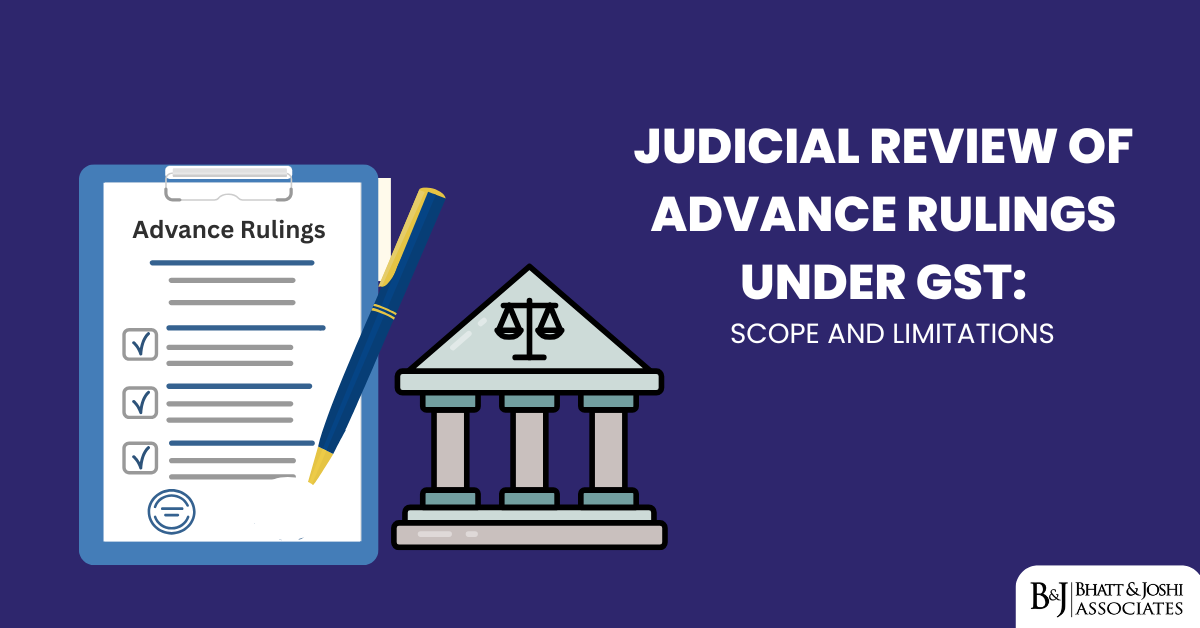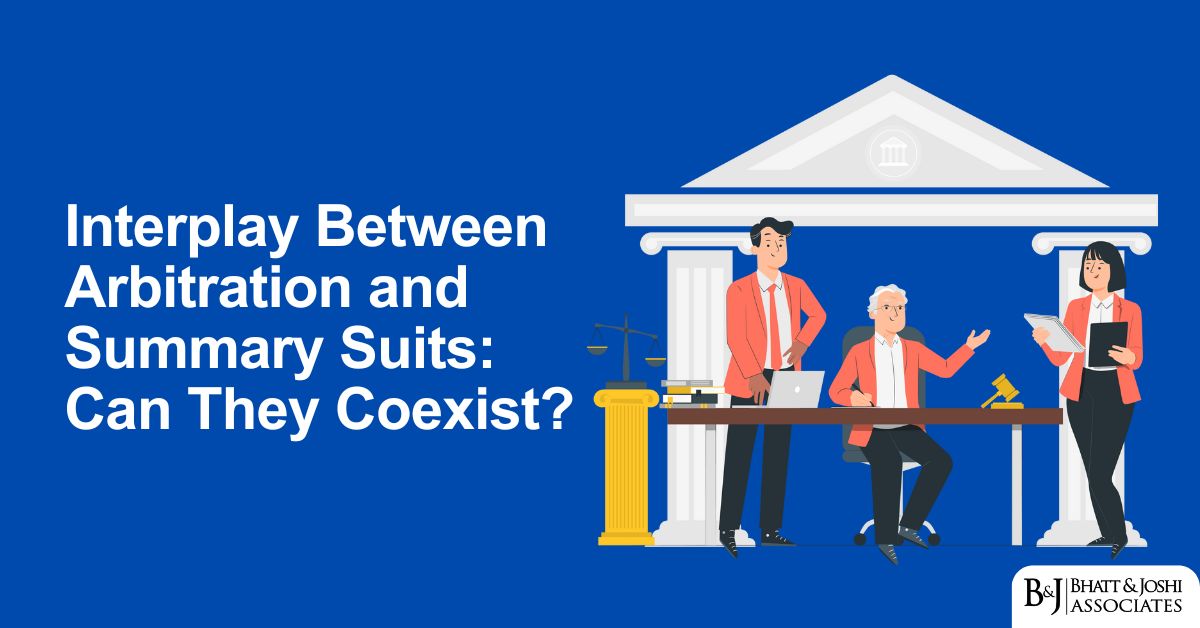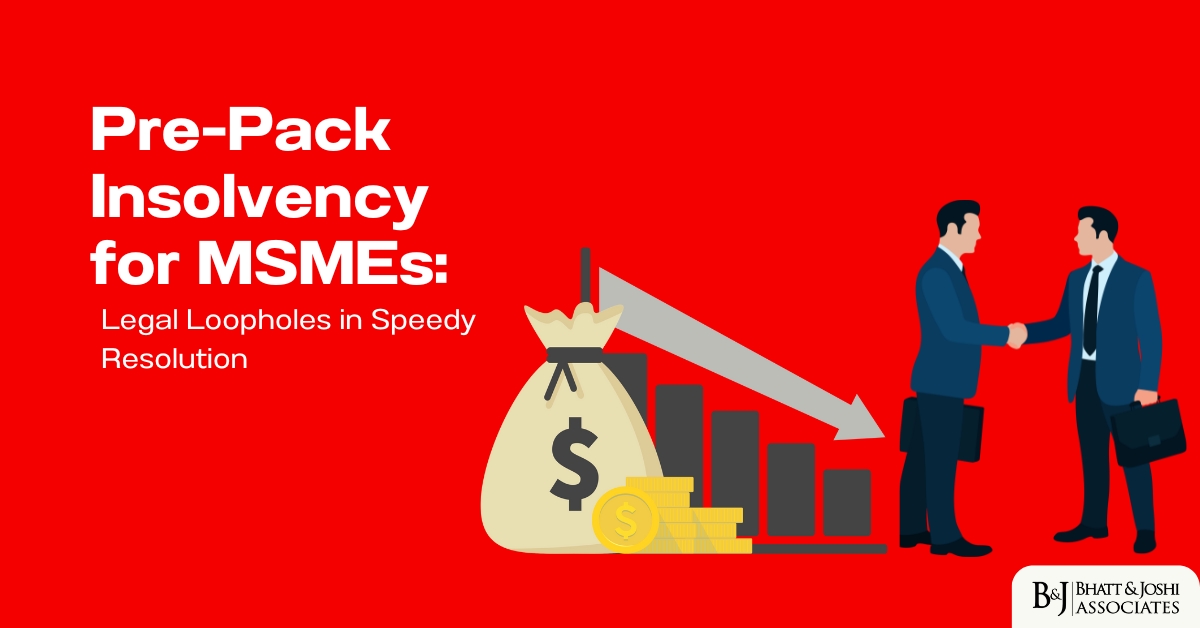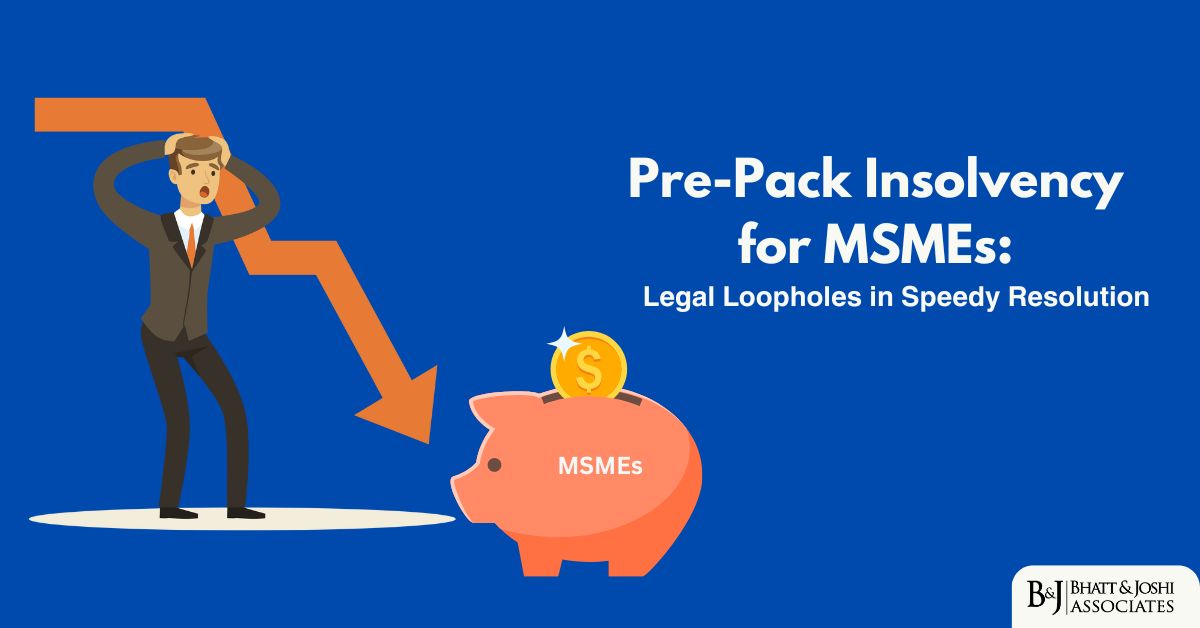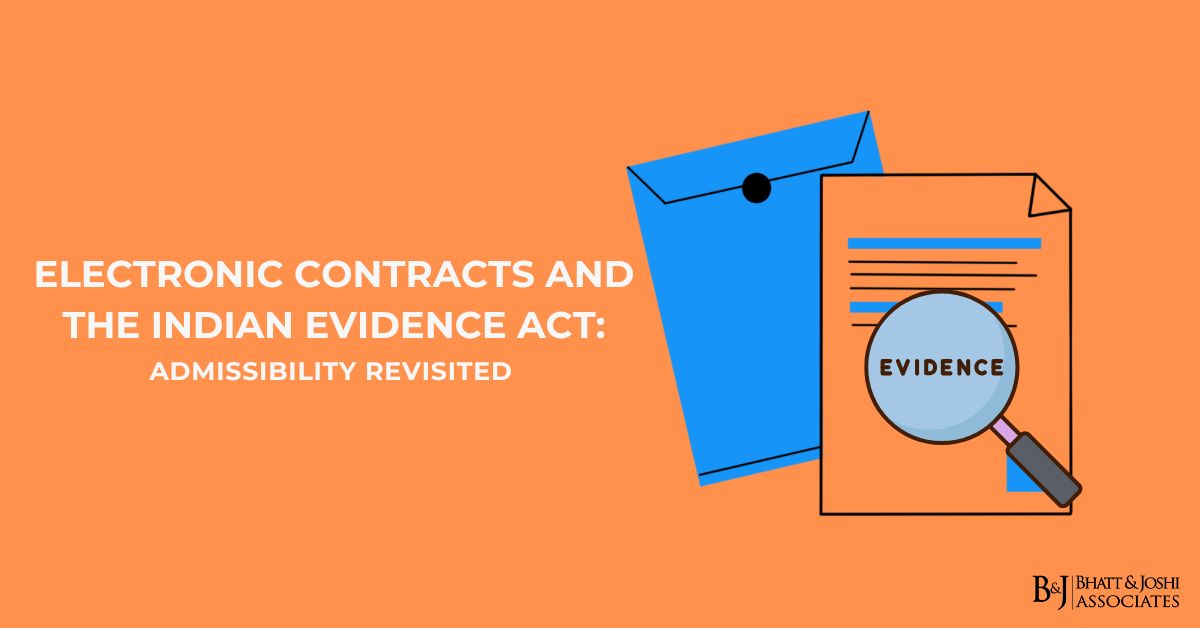Introduction
The introduction of the Goods and Services Tax (GST) in July 2017 marked a watershed moment in India’s indirect tax regime, consolidating multiple taxes into a unified structure. To provide certainty in this new tax landscape, the GST law incorporated the Advance Ruling mechanism – a procedure that allows taxpayers to obtain binding clarifications on specified GST issues before undertaking transactions. While this mechanism aims to provide tax certainty, questions have emerged regarding the scope and limitations of judicial review over such rulings, particularly given their binding nature and limited statutory appeal provisions. This article examines the intricate relationship between Advance Rulings under GST and the constitutional power of judicial review vested in High Courts and the Supreme Court. It navigates through the statutory framework, analyzes landmark judicial pronouncements, identifies key challenges, and explores potential reforms to enhance the effectiveness of this critical aspect of GST administration. The analysis is particularly relevant as the jurisprudence on GST Advance Rulings continues to evolve, shaping both administrative practice and taxpayer strategies in this still-maturing tax regime.
Statutory Framework of Advance Rulings under GST
Legal Provisions of GST Advance Ruling Mechanism
The Advance Ruling mechanism under GST derives its statutory foundation from Chapter XVII of the Central Goods and Services Tax Act, 2017 (CGST Act), comprising Sections 95 to 106. Parallel provisions exist in the respective State GST Acts, creating a comprehensive framework for Advance Rulings at both central and state levels.
Section 95 defines “advance ruling” with remarkable breadth:
“‘advance ruling’ means a decision provided by the Authority or the Appellate Authority or the National Appellate Authority to an applicant on matters or on questions specified in sub-section (2) of section 97 or sub-section (1) of section 100 or of section 101C of this Act, in relation to the supply of goods or services or both being undertaken or proposed to be undertaken by the applicant.”
Section 97(2) specifies the questions on which advance ruling can be sought, including:
“(a) classification of any goods or services or both; (b) applicability of a notification issued under the provisions of this Act; (c) determination of time and value of supply of goods or services or both; (d) admissibility of input tax credit of tax paid or deemed to have been paid; (e) determination of the liability to pay tax on any goods or services or both; (f) whether applicant is required to be registered; (g) whether any particular thing done by the applicant with respect to any goods or services or both amounts to or results in a supply of goods or services or both, within the meaning of that term.”
Institutional Structure of GST Advance Ruling Authorities
The GST law establishes a multi-layered institutional structure for Advance Rulings:
- Authority for Advance Ruling (AAR): Constituted in each State/UT under Section 96, comprising one member from the central tax authorities and one from the state tax authorities.
- Appellate Authority for Advance Ruling (AAAR): Established under Section 99, consisting of the Chief Commissioner of central tax and Commissioner of state tax, to hear appeals against AAR orders.
- National Appellate Authority for Advance Ruling (NAAR): Introduced through the Finance (No. 2) Act, 2019, under Section 101A, to resolve conflicting advance rulings issued by AARs of different states.
Binding Nature and Appeal Provisions under GST Advance Ruling
Section 103 explicitly states that an advance ruling shall be binding on:
“(a) the applicant who had sought it; and (b) the concerned officer or the jurisdictional officer in respect of the applicant.”
The binding nature of these rulings is complemented by limited statutory appeal provisions:
- Section 100 allows appeals to AAAR within 30 days (extendable by 30 days) on grounds of dissatisfaction with the AAR’s ruling.
- Section 101B provides for appeals to NAAR within 30 days (extendable by 30 days) in cases of conflicting advance rulings.
Importantly, the GST law does not explicitly provide for further appeals beyond AAAR or NAAR, raising questions about the finality of these rulings and the scope for judicial review by constitutional courts.
Constitutional Framework for Judicial Review
Writ Jurisdiction of High Courts
Article 226 of the Constitution confers upon High Courts the power to issue writs, including writs of certiorari, mandamus, prohibition, quo warranto, and habeas corpus. This power extends to “any person or authority” within the territorial jurisdiction of the High Court “for the enforcement of any of the rights conferred by Part III and for any other purpose.”
The Supreme Court, in Whirlpool Corporation v. Registrar of Trademarks, Mumbai (1998) 8 SCC 1, clarified the scope of this power:
“The power to issue prerogative writs under Article 226 of the Constitution is plenary in nature and is not limited by any other provision of the Constitution. This power can be exercised by the High Court not only for issuing writs in the nature of habeas corpus, mandamus, prohibition, quo warranto and certiorari for the enforcement of any of the Fundamental Rights contained in Part III of the Constitution but also for ‘any other purpose’.”
Supervisory Jurisdiction of Supreme Court
Article 32 of the Constitution guarantees the right to move the Supreme Court for enforcement of fundamental rights, while Article 136 empowers the Supreme Court to grant special leave to appeal from any judgment, decree, determination, sentence, or order in any cause or matter passed or made by any court or tribunal in India.
In L. Chandra Kumar v. Union of India (1997) 3 SCC 261, the Supreme Court held:
“The jurisdiction conferred upon the High Courts under Articles 226 and 227 and upon the Supreme Court under Article 32 of the Constitution is part of the inviolable basic structure of our Constitution.”
This constitutional position establishes that the power of judicial review remains inviolable and cannot be curtailed even by statutory provisions purporting to grant finality to administrative decisions.
Scope of Judicial Review of Advance Rulings under GST
Grounds for Judicial Review of GST Advance Rulings
The scope of judicial review over GST Advance Rulings has been shaped by evolving judicial pronouncements. Based on established principles of administrative law and specific GST-related decisions, the following grounds for judicial review have emerged:
- Jurisdictional Errors
In Columbia Asia Hospitals Pvt. Ltd. v. Commissioner of Commercial Taxes (2019) 25 GSTL 385 (Karnataka High Court), the court intervened where the AAR had exceeded its jurisdiction by ruling on questions not specifically sought by the applicant. The court observed:
“The Authority for Advance Ruling cannot travel beyond the questions referred to it and adjudicate on matters not specifically sought. Such an exercise would be ultra vires and subject to correction through judicial review.”
- Errors of Law
The Bombay High Court in Dharmendra M. Jani v. Union of India [2021-TIOL-1817-HC-MUM-GST] emphasized that errors of law apparent on the face of the record would warrant judicial intervention:
“While the GST law grants finality to Advance Rulings within their statutory context, this finality cannot extend to palpable errors of law that strike at the root of the ruling. The constitutional courts retain the power to correct such errors through their writ jurisdiction.”
- Violation of Natural Justice
In Enfield Apparels Ltd. v. Authority for Advance Ruling [2020-TIOL-1323-HC-MAD-GST], the Madras High Court set aside an advance ruling where the applicant was not provided adequate opportunity to present their case:
“The principles of natural justice are not mere formalities but substantive safeguards that ensure fair decision-making. Their violation in the advance ruling process renders the resulting determination susceptible to judicial review, notwithstanding the statutory limitations on appeals.”
- Unreasonable or Arbitrary Decisions
The Delhi High Court in MRF Limited v. Assistant Commissioner of CGST & Central Excise [W.P.(C) 4262/2020] intervened where an advance ruling was found to be arbitrary and unreasonable:
“Even decisions of specialized authorities like the AAR and AAAR must satisfy the Wednesbury principles of reasonableness. A ruling that no reasonable authority could have reached is amenable to correction through judicial review.”
Limitations on Judicial Review
While constitutional courts have affirmed their power to review advance rulings, they have also recognized certain limitations:
- Deference to Specialized Expertise
In Sutherland Global Services Private Limited v. Union of India [2021-TIOL-1950-HC-DEL-GST], the Delhi High Court acknowledged the specialized expertise of AARs and AAARs:
“Constitutional courts must approach the review of advance rulings with appropriate judicial restraint, recognizing the specialized expertise of these authorities in GST matters. Mere disagreement with the interpretation adopted by these authorities would not warrant judicial intervention.”
- Alternative Remedy Consideration
The Gujarat High Court in Britannia Industries Ltd. v. Union of India [2020-TIOL-1454-HC-AHM-GST] emphasized the need to exhaust statutory remedies before seeking judicial review:
“The extraordinary jurisdiction under Article 226 should not ordinarily be exercised when the statute provides an alternative remedy. An aggrieved applicant should first approach the Appellate Authority for Advance Ruling before seeking judicial review, unless exceptional circumstances warrant direct intervention.”
- Self-Imposed Restraint on Questions of Fact
In Smartworks Coworking Spaces Private Limited v. AAR, Delhi [W.P.(C) 8496/2021], the Delhi High Court declined to interfere with factual findings:
“Constitutional courts exercising writ jurisdiction should refrain from reassessing factual determinations made by the AAR or AAAR. Judicial review in such cases is limited to examining whether the factual findings are based on relevant material and are not perverse.”
Key Judicial Decisions on GST Advance Rulings and Their Review
High Court Decisions
- Sony India Pvt. Ltd. v. Authority for Advance Ruling [2022-TIOL-1421-HC-DEL-GST]
The Delhi High Court addressed the question of whether an AAR’s interpretation of the GST law could be reviewed under Article 226. The court held:
“While the AAR’s determinations are binding within the statutory framework, they remain subject to the High Court’s constitutional oversight. When an interpretation adopted by the AAR is manifestly erroneous and has significant legal implications, the High Court can exercise its writ jurisdiction to correct such error, despite the finality accorded to advance rulings under Section 103.”
- Jumbo Bags Ltd. v. The Appellate Authority for Advance Ruling [2021-TIOL-2142-HC-MAD-GST]
The Madras High Court examined the scope of review over AAARs and observed:
“The appellate authority under GST is not merely an administrative body but exercises quasi-judicial functions that significantly impact taxpayers’ rights. The High Court’s power to review such decisions stems not just from detecting jurisdictional errors but extends to ensuring that these authorities function within the legal framework and adhere to principles of reasoned decision-making.”
- ABB India Limited v. The Authority for Advance Ruling [2022-TIOL-53-HC-KAR-GST]
The Karnataka High Court set an important precedent by clarifying the relationship between advance rulings and established judicial precedents:
“An Authority for Advance Ruling, despite its specialized role, cannot issue rulings that contradict binding precedents of the High Court or Supreme Court. Such rulings would suffer from a fundamental legal infirmity warranting intervention through judicial review.”
Supreme Court Guidance
While the Supreme Court has not issued comprehensive guidelines specifically on judicial review of GST advance rulings, its observations in analogous contexts provide valuable guidance.
In Godrej & Boyce Manufacturing Company Ltd. v. Commissioner of Income Tax (2017) 7 SCC 421, dealing with advance rulings under income tax law, the Supreme Court noted:
“The power of judicial review over specialized tribunals or authorities must be exercised with circumspection, recognizing their domain expertise. However, this restraint cannot extend to situations where such authorities act in excess of jurisdiction, commit errors of law, violate principles of natural justice, or reach conclusions that no reasonable authority could have reached.”
This approach, while articulated in the income tax context, offers a framework applicable to GST advance rulings as well.
Procedural Aspects of Judicial Review
Standing to Challenge Advance Rulings
A critical procedural aspect concerns who can challenge an advance ruling through judicial review. Section 103 states that advance rulings are binding only on the applicant and the concerned officers. However, judicial precedents have expanded the scope of standing:
In Bahl Paper Mills Ltd. v. State of Madhya Pradesh [2022-TIOL-987-HC-MP-GST], the Madhya Pradesh High Court recognized the standing of similarly situated taxpayers:
“While an advance ruling is statutorily binding only on the applicant and concerned officers, its precedential effect cannot be ignored. Where a ruling has industry-wide implications or affects a class of taxpayers similarly situated, such taxpayers have the requisite locus standi to challenge the ruling through judicial review, though they were not applicants before the AAR.”
Timeframe for Judicial Review
Unlike the 30-day limitation period for statutory appeals to AAAR or NAAR, there is no explicit limitation period for seeking judicial review. However, courts have applied the doctrine of laches:
In Hinduja Leyland Finance Ltd. v. Commissioner of GST & Central Excise [2021-TIOL-1652-HC-MAD-GST], the Madras High Court noted:
“While no rigid timeframe governs the exercise of writ jurisdiction, unreasonable delay in challenging an advance ruling may disentitle the petitioner to relief, particularly where significant financial arrangements or business decisions have been made in reliance on the ruling.”
Interim Relief Pending Judicial Review
The question of interim relief during pendency of judicial review has also been addressed by courts:
In Nipro India Corporation Pvt. Ltd. v. Union of India [2020-TIOL-1591-HC-DEL-GST], the Delhi High Court granted interim relief suspending the operation of an advance ruling:
“Where prima facie the advance ruling appears to suffer from serious legal infirmities and its immediate implementation would cause irreparable harm to the petitioner, the High Court may grant interim relief suspending its operation, subject to appropriate conditions to balance competing interests.”
Challenges in the Current Framework of GST Advance Rulings
Conflicting Rulings Across States
One of the most significant challenges in the current framework is the issuance of conflicting advance rulings by AARs in different states on identical issues. While the introduction of NAAR was intended to address this issue, its delayed operationalization has perpetuated uncertainty.
In Integrated Decisions and Systems India Pvt. Ltd. v. State of Maharashtra [2021-TIOL-1774-HC-MUM-GST], the Bombay High Court highlighted this problem:
“The proliferation of contradictory advance rulings across states on identical issues undermines the very purpose of the advance ruling mechanism – to provide certainty and uniformity in tax treatment. This divergence necessitates a more robust system of judicial review to harmonize interpretations until the National Appellate Authority becomes fully operational.”
Limited Technical Expertise in Constitutional Courts
Another challenge concerns the technical expertise required to review complex GST matters. In Torrent Power Ltd. v. Union of India [2020-TIOL-1126-HC-AHM-GST], the Gujarat High Court acknowledged this limitation:
“Constitutional courts, while equipped to address questions of law and jurisdiction, may face challenges in navigating the technical complexities of GST classification and valuation. This reality calls for a balanced approach that respects the specialized expertise of AARs while ensuring adherence to legal principles.”
Potential for Regulatory Uncertainty
The interplay between advance rulings and judicial review can create regulatory uncertainty, as noted by the Calcutta High Court in Manyavar Creations Pvt. Ltd. v. Union of India [2021-TIOL-1548-HC-KOL-GST]:
“The possibility that advance rulings, despite their intended finality, may subsequently be overturned through judicial review creates a layer of uncertainty for taxpayers. This tension between finality and reviewability requires careful navigation to maintain the efficacy of the advance ruling mechanism.”
Comparative Analysis with Other Jurisdictions
United Kingdom’s Approach
The United Kingdom’s tax ruling system allows for judicial review of advance rulings issued by Her Majesty’s Revenue and Customs (HMRC). In R (on the application of Glencore Energy UK Ltd) v. HMRC [2017] EWCA Civ 1716, the Court of Appeal established that rulings could be reviewed for errors of law, procedural impropriety, or irrationality – a framework similar to India’s evolving approach.
Australian Model
Australia’s private ruling system under the Taxation Administration Act 1953 explicitly provides for judicial review, with the Administrative Appeals Tribunal and Federal Court having jurisdiction to review rulings. This structured approach provides greater certainty regarding the reviewability of rulings.
Lessons from European Union
The European Union’s VAT Directive includes provisions for advance rulings with varying approaches to judicial review across member states. The Court of Justice of the European Union has emphasized the importance of effective judicial protection, a principle that resonates with India’s constitutional framework.
Reform Proposals for Advance Rulings under GST
Statutory Recognition of Judicial Review
A potential reform could involve explicit statutory recognition of the power of High Courts and the Supreme Court to review advance rulings, clarifying the grounds, procedure, and limitations of such review. This would provide greater certainty to taxpayers and tax authorities alike.
Section 103 could be amended to include a provision such as:
“Notwithstanding the binding nature of advance rulings as specified in this section, nothing in this Act shall be construed to limit the constitutional power of the High Courts under Article 226 or the Supreme Court under Articles 32 and 136 to review such rulings on grounds of jurisdictional error, error of law, violation of natural justice, or manifest unreasonableness.”
Enhanced Technical Capacity in Courts
Establishing specialized GST benches within High Courts, comprising judges with taxation expertise, could enhance the quality of judicial review. Additionally, provisions for technical members or expert advisors could be introduced to assist courts in navigating complex GST issues.
Streamlined Procedure for Challenges
Developing a streamlined procedure specifically for challenges to advance rulings could enhance efficiency. This might include:
- Special format for petitions challenging advance rulings
- Accelerated timelines for disposal
- Standardized requirements for interim relief
Publication and Precedential Value
Mandating the publication of all advance rulings and judicial decisions reviewing them, along with clear guidelines on their precedential value, would enhance transparency and consistency in the GST regime.
Conclusion
The judicial review of advance rulings under GST represents a delicate balancing act between administrative finality and constitutional oversight. As the jurisprudence in this area continues to evolve, it is increasingly apparent that constitutional courts play a vital role in ensuring that the advance ruling mechanism fulfills its intended purpose of providing certainty while adhering to fundamental legal principles.
The current framework, characterized by limited statutory appeal provisions and the inviolable power of judicial review, creates both challenges and opportunities. The challenges include potential uncertainty, inconsistent approaches across jurisdictions, and questions about the appropriate scope of review. The opportunities lie in the potential for courts to harmonize interpretations, correct jurisdictional overreach, and ensure adherence to principles of natural justice.
As the GST regime matures, a more structured approach to judicial review of advance rulings is likely to emerge, potentially incorporating elements from other jurisdictions while respecting India’s unique constitutional framework. This evolution will require thoughtful engagement from legislature, judiciary, tax authorities, and taxpayers to develop a system that balances efficiency, certainty, expertise, and constitutional values.
The path forward lies not in restricting judicial review but in refining its exercise to ensure that it enhances rather than undermines the advance ruling mechanism. Such refinement, coupled with operational improvements to the AAR, AAAR, and NAAR framework, would strengthen India’s GST system by providing taxpayers with the dual benefits of administrative expertise and judicial safeguards.
In the final analysis, the scope and limitations of judicial review of advance rulings under GST reflect broader constitutional principles that balance administrative efficiency with legal oversight. The evolving jurisprudence in this area will play a crucial role in shaping the future of India’s GST regime, ensuring that it remains both technically sound and constitutionally compliant. As courts continue to clarify the contours of judicial review in this context, taxpayers, practitioners, and administrators would be well-advised to monitor these developments closely, recognizing their significant implications for tax planning, compliance, and dispute resolution strategies.





